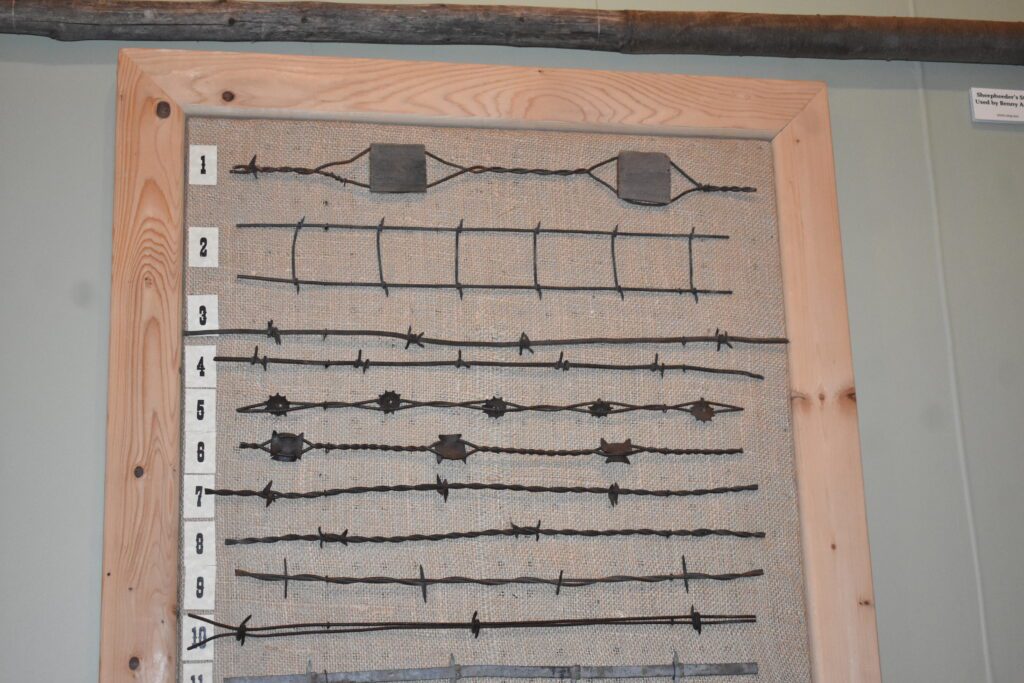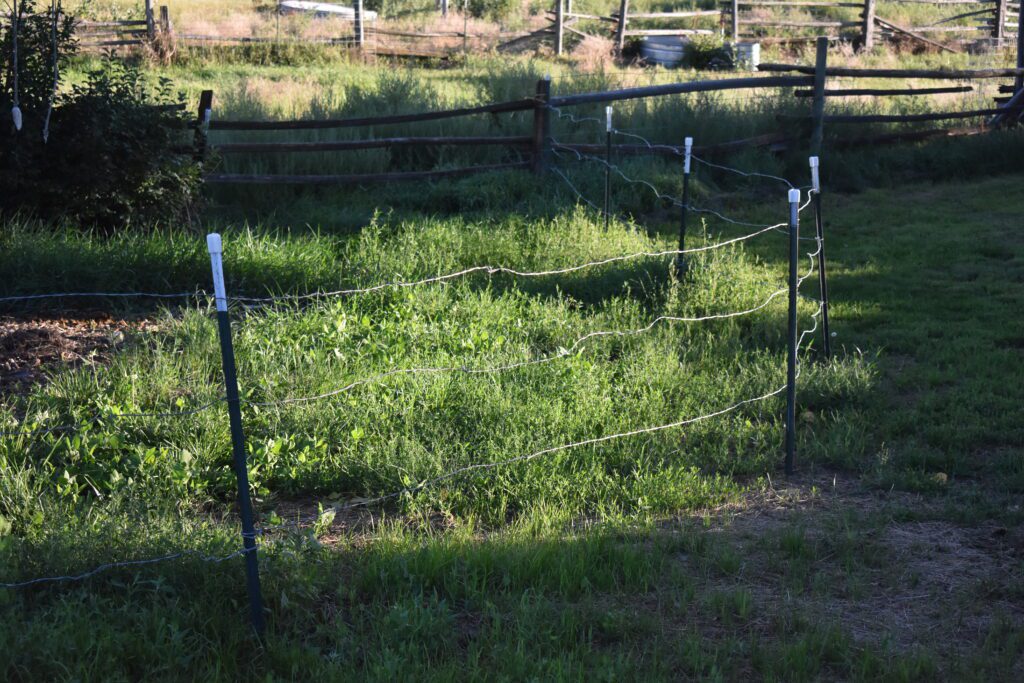News
History: Barbed Wire in Wyoming

Today, barbed wire or barb wire fences are a common sight in Wyoming. Around ranchers’ pastures and along rural highways throughout the state.
In August of 1887, and inventor named Hodge received a patent for ‘spur rowel barb wire’. Other types of barbed wire were patented as well, including in France. Barbed wire was used in World War 1 as well. Wire fences in the West changed the way that cattle were raised, making fencing the open range cheaper and easier. It helped to bring an end to the open range culture in the West.

Wyoming cattlemen, homesteaders and sheep men used the cheap fencing to mark the boundaries of their lands, help keep wildlife and the open range cattle out of their crops, and, after the killing winter of 1886-87, to keep the livestock in close so they could be fed hay in the winter.
From The Wyoming Industrial Journal, July 1, 1902 – This year probably not single herd of cattle will be driven up from Texas and Mexico to the green pastures of Colorado, Kansas, Wyoming and Montana. It was the old cattle trail that made this western country famous. few years ago, as soon as spring opened the great herds of cattle were rounded up and started north to the pastures along the valleys of the Missouri and northern rivers. The grass along the way was enough to run the cattle until the big pastures were reached. Tens of thousands of cattle crossed Colorado in this manner during the past years, but it is different now. When it once took ninety days to make the long trip across the plains the cattle are now placed in train of cars and hustled through in ninety hours. Wire fences, the disappearance of grasses and the deflection of streams of water have eradicated the historic cattle trail. Then too, the time is here when the demand for cattle makes it imperative that they be moved as quickly as possible and fattened for the market. Transportation officials of the railroads running west and north are now busy providing means for transporting the great number of cattle this year. It is the greatest rush in the history of the West.

From The Wyoming Industrial Journal, August 1, 1901- Feeding in winter seems to be increasing all over the far West and new methods are rapidly being introduced in the range country. The times change and we change with them, and this adage is as true in our range countries as anywhere else. The old-time cow-puncher is being consigned to oblivion and new race is springing up. The haphazard style of the eighties is drifting away, and new era has begun. Barbed wire has been great factor in these changes.
The severe winter “The Great Die-Up” of 1886-87 also had a lot to do with ending the open range culture.
This was in The Wyoming State Journal (Laramie), on June 20, 1891 – Evolution in Stock Growing from Colorado Field and Farm. Within the past decade the methods of livestock growing have radically changed. The ranges, once part of the public domain, have been encroached upon by the actual settler, their area rapidly lessened and bristling fences of barbed wire now stand as menace to the foraging herds where few years since cattle, horses and sheep roamed at will. There are thousands of acres of public grazing on the plateaus of our mountains, and foothill country in summer, upon which many thousands of graziers obtain their subsistence in summer, but the winter ranges are rapidly becoming thing of the past, and feeding must be resorted to in the future growing of livestock. Some of the old timers in the cattle business shake their heads and say that the cattle business has seen its best days. Others who have studied the subject of raising cattle from different standpoint, do not look upon the matter in the same light, but see in the summer grazing and winter feeding the problem of successful and profitable stock growing solved. The truth is that within the next five years Colorado will have within her confines class of cattle, sheep and horses of value almost double that of the present. Fenced pastures, fodder crops and unproved feeding racks will be the order of the day henceforth.
The same could have been said of Wyoming. Today, putting up hay and feeding livestock in the winter is a normal part of ranch life.

Barbed wire was not popular with everyone, and it took livestock some time to discover that it could cause them injury and learn to avoid running into it.
From The Sundance Gazette, January 28, 1887 – Barbed Wire Fence. Justice Magie, of the supreme court of New Jersey, has made a decision on the subject of barbed wire fences which will he of wide interest. Hudson had a field enclosed with a barbed wire fence, and Mr. Polak owned a fine colt which he put to pasture in a field adjoining that of Hudson. The colt received injuries from the fence which necessitated its being killed, and Polak sued Hudson for its value.
Judge Magie, in delivering an opinion in the case, held as follows: “No owner of a field has a right to erect any fence without taking into consideration the natural habits of the animals that are likely to be kept in the adjoining field, ‘their habits in their playfulness, their disposition to stray, even their disposition to break through,’ and that any fence which is likely, from the habits of the animals, to produce injury to them, is illegal, and the person erecting it is liable for the damage it does.” It is said that the barbed wire manufacturers will interest themselves in the case and carry it to the highest courts.

There is even a statute in Wyoming on what constitutes a legal fence, this was as early as 1887.
This from the Lusk Herald Friday, Aug 19, 1887 – Lawful Fences. The Revised Statutes of Wyoming define a Lawful Fence as Follows; – Sec. 4, 192: The following shall be a lawful fence in the territory of Wyoming: A fence made of tubular wrought-iron fence posts, or wooden posts, and three span of barbed wire, or two span of barbed wire and one span of plain wire, said posts used, to be tubular wrought iron fence posts with a cast iron base to be twenty two inches in length or wooden posts four inches in diameter, either of said posts to be used to be placed at no greater distance apart than eighty feet, with iron or wooden stays not more than sixteen and one-half feet apart.
* * *
Such plain wire as before described shall not be less than number eight wire, and all wires shall be kept properly stretched. And it is further provided that none of the above-described fences shall be considered lawful if less than four feet in height.
The liabilities for damages is given the following:
Sec. 4,194. Any person or persons who shall construct any barbed wire fence contrary to the provisions of Section forty-one hundred and ninety-two shall be liable for all damages to animals that may occur for the non-compliance with the above section, such damages to be collected in the same manner as damages from other causes as provided by law.

And from the Thermopolis Independent, May 7, 1915 – Notice to all Persons Owning Barbed Wire Fences. Many complaints are coming to my office from residents of this county on account of loose barbed wire and badly deteriorated barbed wire fences in different parts of the county, and several men have suffered damages by reason of stock being injured in loose wire and badly maintained fences. The law makes it a misdemeanor for any person to build or maintain an unlawful fence. Therefore, notice is hereby given that all persons who own or control any loose barbed wire or badly constructed fences in Hot Springs County, on or adjacent to the open range, and who do not immediately remove or rebuild the same, will be prosecuted. Fred Wyckoff, County Attorney.
Things are constantly changing, and in the late 1800s, barbed wire made an enormous change in the way ranchers raise their cattle on Wyoming ranges.

